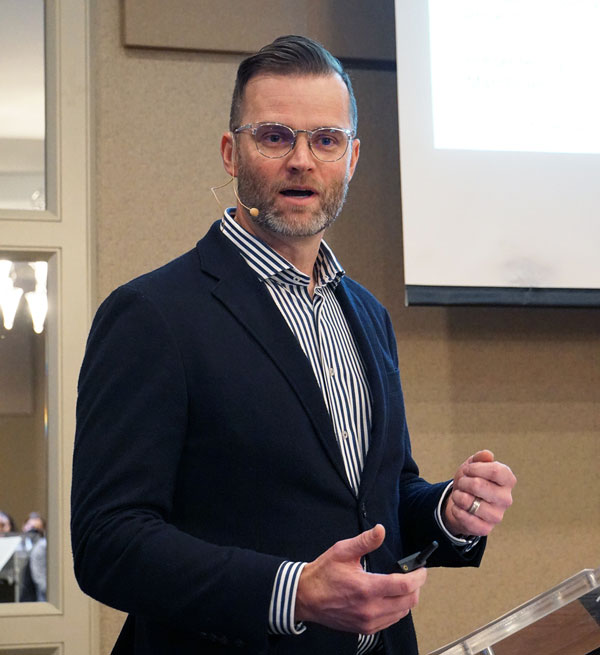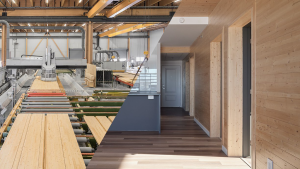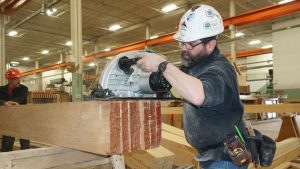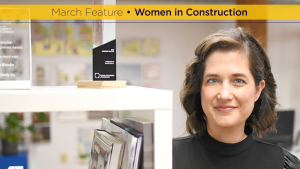A Kitchener, Ont.-based architect sees plenty of opportunities for mass timber to help solve the affordable housing crisis.
Matt Bolen, principal with EDGE Architects, said the firm’s design of the recently completed four-storey transitional housing complex for women in Kitchener is a case in point.
Delivered in only one year, the net-zero-ready project illustrates how quickly mass timber buildings can be constructed for the right price with the right team.
A modular constructed design, it features cross-laminated timber (CLT) structural elements arranged to maximize efficiencies and minimize installation time. Panels are roughly 40 feet long, in the same range as precast hollow-core panels, but the CLT panels are three times as wide as precast achievable partly because of the light weight of wood.

“That’s one third the number of picks off a truck and should also relate to cost (savings),” Bolen told a seminar audience on the project recently at the 2022 Toronto Wood Solutions Conference hosted by the Canadian Wood Council.
He added a fundamental difference with the design and precast is the mass timber structure has “multi points of spanning across one panel length. It increases your stiffness significantly and allows you to decrease the thickness of the product.
“We knew we had to be competitive with other standardized projects using precast and other methods, but we were also competing in an RFP that had a number associated to it and that had shipping container groups responding to it.”
The challenge also was to create a building that is efficient over the long run in terms of the capital costs versus the payback on energy.
Geared to women battling homelessness, the project is comprised of 41 one-bedroom units with exposed mass timber interiors. It is operated by the YW Kitchener-Waterloo (KW), the local branch of the YMCA.
The project has received funding through the CMHC’s Rapid Housing Initiative.
“It is not an overly complex project and that was an important part of the design” to meet the rapid housing parameters, Bolen said.
“We had to have something that would be streamlined. As a lot of us architects and construction-minded folks know construction contracts are an important part of what we do so trying to change them, disrupt them or come up with wildly different contractual arrangements” wouldn’t work.
Completing the design, approvals and construction in only 12 months seemed “pretty insane at the time and I still don’t know how I convinced our construction partners to agree to it,” he said.From the outset EDGE retained mass timber manufacturer Element5 in a design-assist role to help pull together a team that could respond quickly to the tight schedule.
While assembling consultants and contractors with “shared interests, aligned motivations” was a start, Bolen said securing players with the expertise to respond to specific site issues was essential as well.
The building science experts at RDH were instrumental to YW KW’s success in the field, navigating through the complexities of the EIFS and moisture control systems.
“It is such an important piece.”
Bolen added on such public sector projects, having team members who understand the financing model, procurement and approvals process are equally important in tight budget, rapid housing projects.
“The process we followed, the team we built and I think the design and the quality and warmth of the product really is significant,” he told the audience.
He said YW KW is not a “one-off,” and the firm will lead on more rapid housing designs. It recently assisted R-Hauz on a rapid housing project in East Gwillimbury called Passage House.
EDGE’s rapid housing model evolved out of a prototype for an office building with a long-span system. On that prototype the firm teamed up with Element5 on design but the proposal fell through when the office market tanked during the pandemic.
EDGE’s first experience with mass timber was in 2017 on the design of a midrise residence in Kitchener. At the time there wasn’t enough certainty on the cost, supply and installation details of mass timber for private sector developers to take on the risk so the building ended up being designed in a hybrid of CLT and Hambro composite systems.
Held at the Parmount Event Space in Woodbridge, the day-long Wood Solutions Conference featured a number of seminars and an exhibitors hall.











Recent Comments
comments for this post are closed